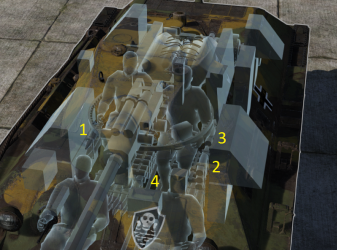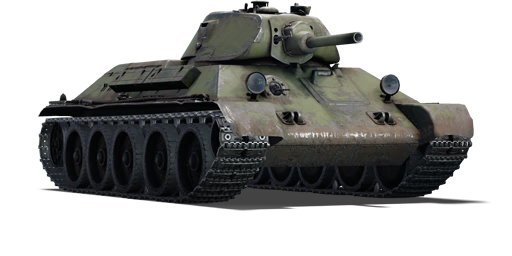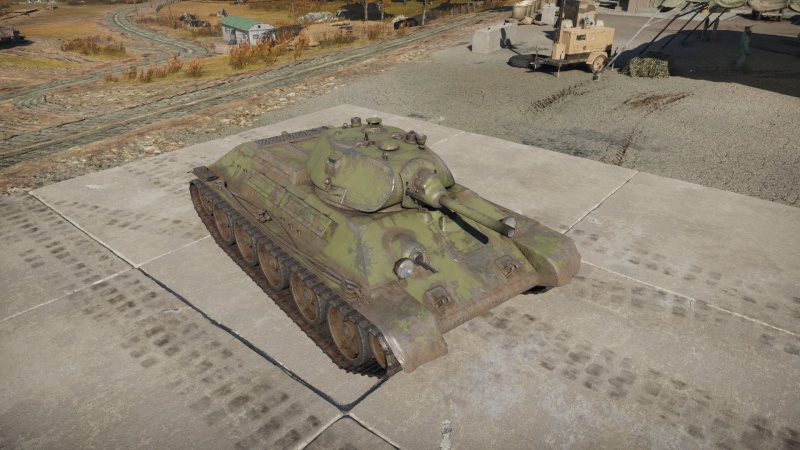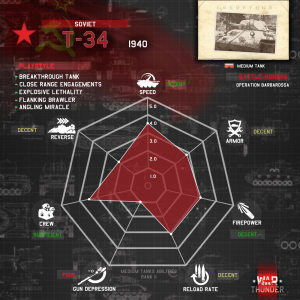T-34 (1940)
| This page is about the Soviet medium tank T-34 (1940). For other versions, see T-34 (Disambiguation). |
Contents
Description
The T-34 (1940) is a rank II Soviet medium tank with a battle rating of 3.3 (AB/RB) and 2.7 (SB). It was introduced during the Closed Beta Test for Ground Forces before Update 1.41. The first public iteration of the T-34 series, the T-34 1940 shows most of the early Soviet weaponry but provides a demonstration of its famous sloped armour and mobility.
The T-34 mod. 1940, like all the other T-34s, is fairly quick and manoeuvrable, decently armed, and decently armoured. It is the first researchable T-34 and the "oldest" (worst) model, aside from the T-34 prototype. It is notable for its distinct appearance, with its broad, sloped front, large road wheels, and comparatively narrow turret. It is distinguished from all other T-34/76 models in that it has the L-11 gun (the same gun as mounted on the KV-1 (L-11)), as opposed to the more powerful F-34. It is identified by its low-slung barrel, with a recuperator creating a bulge above it. The vehicle's speed allows it to be a versatile flanker, but its armour keeps it competitive enough to be a brawler. It will also bounce somewhat frequently so angling the armour, as with any T-34, is helpful. The gun is decent for its rank but will struggle to penetrate other T-34s, KV tanks, M4 Shermans, and similar vehicles from the front.
General info
Survivability and armour
Armour type:
- Rolled homogeneous armour
- Cast homogeneous armour (Gun mantlet, Driver's hatch, Machine gun port)
| Armour | Front (Slope angle) | Sides (Slope angle) | Rear | Roof |
|---|---|---|---|---|
| Hull | 45 mm (60°) Front Glacis 45 mm (53°) Lower Glacis 45 mm (61°) Driver's Port 45 mm (28-77°) Machine Gun Port |
40 mm (40°) Top Hull 45 mm (0°) Lower hull |
40 mm (47°) Top 40 mm (46°) Bottom |
20 mm |
| Turret | 45 mm (8-81°) Turret front 45 mm (3-74°) Gun mantlet |
45 mm (30-31°) | 45 mm (30°) | 15 mm |
Notes:
- Suspensions wheels and tracks are 20 mm thick.
The T-34 1940 can pose a formidable enemy at its BR (3.3) and one might find it a resilient and stubborn foe. If your vehicle can reliably penetrate 90mm (more if the vehicle is angled) of armour at medium to long-range, you should try to eliminate the T-34 at the longest possible range, where the L-11 gun will perform poorly. If your weapon cannot reliably penetrate 90mm of armour and you are forced to close the distance, be wary of your foes mobility. Brawling with a T-34 1940 is not recommended, the mobility and armour of the vehicle combined with a quick turret rotation speed may prove fatal. However, the T-34 is not an invincible foe. The T-34 1940 has a weak turret, which even some rank 1 guns can penetrate! It is recommended to aim for the turret ring, as the cramped crew compartment will result in an easy crew kill. Another weakspot of the T-34 is the turret cheeks - there are some flat spots that are 45mm, disabling the turret crew and the gun. A shot may ricochet off the turret cheeks into the crew compartment.
Mobility
| Game Mode | Max Speed (km/h) | Weight (tons) | Engine power (horsepower) | Power-to-weight ratio (hp/ton) | |||
|---|---|---|---|---|---|---|---|
| Forward | Reverse | Stock | Upgraded | Stock | Upgraded | ||
| Arcade | 55 | 8 | 25.6 | 775 | 954 | 30.27 | 37.27 |
| Realistic | 49 | 7 | 442 | 500 | 17.27 | 19.53 | |
Modifications and economy
Armaments
Main armament
| 76 mm L-11 | Turret rotation speed (°/s) | Reloading rate (seconds) | |||||||||||
|---|---|---|---|---|---|---|---|---|---|---|---|---|---|
| Mode | Capacity | Vertical | Horizontal | Stabilizer | Stock | Upgraded | Full | Expert | Aced | Stock | Full | Expert | Aced |
| Arcade | 77 | -5°/+25° | ±180° | N/A | 23.80 | 32.94 | 40.00 | 44.24 | 47.06 | 9.23 | 8.17 | 7.53 | 7.10 |
| Realistic | 14.88 | 17.50 | 21.25 | 23.50 | 25.00 | ||||||||
Ammunition
- BR-350A: Most versatile of all the ammo types, with a decent penetration of ~80 mm and with an explosive filler for maximum damage. If a shot penetrates an enemy tank, the 150 g of explosives will decimate the crew.
- BR-350SP: More penetration than 350A with about 76 mm of penetration at 100 meters, but no explosive filler for more internal damages.
- OF-350M: Standard high-explosive shell for use against unarmoured targets.
- Sh-354T: Shrapnel shell with nearly same damage potential as high-explosive, but has some penetration capabilities that allows the round to do maximum damage at light armour vehicles by exploding inside the tank.
| Penetration statistics | |||||||
|---|---|---|---|---|---|---|---|
| Ammunition | Type of warhead |
Penetration @ 0° Angle of Attack (mm) | |||||
| 10 m | 100 m | 500 m | 1,000 m | 1,500 m | 2,000 m | ||
| BR-350A (MD-5 fuze) | APHEBC | 78 | 76 | 69 | 61 | 53 | 47 |
| BR-350SP | APBC | 93 | 91 | 83 | 74 | 66 | 58 |
| OF-350M | HE | 10 | 10 | 10 | 10 | 10 | 10 |
| Sh-354T | Shrapnel | 37 | 35 | 29 | 25 | 20 | 17 |
| Shell details | |||||||||
|---|---|---|---|---|---|---|---|---|---|
| Ammunition | Type of warhead |
Velocity (m/s) |
Projectile Mass (kg) |
Fuse delay (m) |
Fuse sensitivity (mm) |
Explosive Mass (TNT equivalent) (g) |
Ricochet | ||
| 0% | 50% | 100% | |||||||
| BR-350A (MD-5 fuze) | APHEBC | 615 | 6.3 | 1.2 | 14 | 150 | 48° | 63° | 71° |
| BR-350SP | APBC | 615 | 6.78 | N/A | N/A | N/A | 48° | 63° | 71° |
| OF-350M | HE | 615 | 6.2 | 0.05 | 0.1 | 621 | 79° | 80° | 81° |
| Sh-354T | Shrapnel | 615 | 6.2 | 0.5 | 8 | 85 | 62° | 69° | 73° |
Ammo racks

| Full ammo |
1st rack empty |
2nd rack empty |
3rd rack empty |
4th rack empty |
Visual discrepancy |
|---|---|---|---|---|---|
| 77 | 75 (+2) | 72 (+5) | 69 (+8) | 1 (+76) | No |
Turret empty: 69 (+8)
Machine guns
| 7.62 mm DT | ||||
|---|---|---|---|---|
| Mount | Capacity (Belt) | Fire rate | Vertical | Horizontal |
| Coaxial | 1,890 (63) | 600 | N/A | N/A |
Usage in battles
This is the first non-premium model of the T-34 series. It's a powerful breakthrough tank in the right hands due to its battle rating, good armour and powerful gun but is prone to get heavily damaged or destroyed from shots to the turret ring or cheeks. Keep moving, using its high speed and manoeuvrability, and get close to guaranteeing a penetration and angle the armour to easily bounce shells from enemy tanks.
The T-34 features great speed and agility, together with a good turret traverse and reload speed. It is best used in groups employing flanking manoeuvres and focusing on the impressive speed of the vehicle to catch players off-guard. The armour is also thick and sloped, allowing it to bounce the shots from the short 75mm's and the high-velocity 50mm's on German tanks although the Panzer. IV Ausf. F2's gun will easily go through the sides or UFP even with moderate angling.
At 3.3 the T-34 1940 faces a lot of German and Japanese armour. These Axis tanks tend to have very flat and thin armour which make the 76mm APHE shell extremely effective. The high HE filler makes one-shotting Panzers, Chi-Ha's, etc., very easy. At range, however, Axis long-guns excel - get up close and personal to your opponents.
Common opponents:
- Medium Tank M4, M4A2 (American): The T-34's 76 mm gun cannot penetrate the welded hull M4/M4A2 reliably from the front, while the 75 mm gun on the M4/M4A2 can penetrate the T-34's turret and disable or cripple it. They do have very weak lower side hull armour (only 38 mm) that can be overmatched by the 76 mm APHEBC round if exposed, and the flat areas on the turret can also be penetrated fairly reliably if they can be hit. Generally avoid head-on engagements, especially if the M4 is hull-down.
- Medium Tank M4A1, Sherman II (American/French, British): Similar to the M4/M4A2, except that the cast hull is weaker than the welded hull on the M4/M4A2, and can be penetrated frontally. Otherwise, the same advice applies.
- Pz.Kpfw. IV Ausf. F2, G, H, J (German): The Ausf. F2 variant is the first Panzer IV to mount a long-barreled 75 mm gun. This gun is one of the most lethal mounted on any tank within the T-34's BR range, and it is easily capable of penetrating the T-34 at most ranges. The Ausf. F2 has very weak armour, however, and is something of a glass cannon. The Ausf. G, H, and J have up-armoured hulls that are quite difficult to penetrate, but their turrets are as weak as the one on the F2. The Ausf. J, in particular, has manual turret traverse and is very vulnerable to being flanked. Avoid long-range duels with them.
- Chi-Nu II (Japanese): Essentially the Japanese counterpart to the German Panzer IV Ausf. F2.
- Churchill III, Churchill(e) (British, German): The 6-pounder gun on the Churchill will be hard-pressed to penetrate the sloped T-34 hull, but it can easily penetrate the turret and disable the turret crew. It is difficult to penetrate the frontal armour of the Churchill at long ranges. However, it is a slow, cumbersome heavy tank, and is easy to outflank and dispatch with shots to the side armour.
Pros and cons
Pros:
- Excellent post-penetration effect with the BR-350B, easily one-shotting most tanks it sees, for example Pz.IV F2, M4, Chi-Nu
- Sloped hull armour provides good protection against small calibre / low-penetration shells (eg. 75mm KwK37, 50mm KwK39), and even large calibre guns when angled correctly
- 49 km/h top speed allows it to change position quickly and outrun lots of other medium tanks
- Nearly impossible to damage the transmission and immobilize it from the front
- Very fast turret traverse, good for urban combat
Cons:
- The 4 crew members are very close together making it easily one-shotted by common foes like Pz.IV F2, M24, StuG III F, M4, etc when penetrated from the front / side hull, or even the turret.
- -5 degrees gun depression is below average, making it ineffective to combat in hills comparing to the M4 with -10 degrees depression
- Rather long reload time means the player must carefully aim each shot
- Large fuel tanks scattered at the sides of the hull, tend to catch fire if being hit
- Despite not having APCR, the AP all lack the penetration against more heavily armoured foes like the StuH 42 G
- L-11 cannon has a lower muzzle velocity and penetration than the F-34
History
Development
By 1939, the most numerous tank models in the Red Army were the T-26 and the BT-series light tanks. Though adequate on the days they were introduced, they are now outdated by this time due to the changing technology in anti-tank warfare. Back in 1937, a new tank project was already taking place under engineer Mikhail Koshkin, who was assigned to lead a design team at the Kharkiv Locomotive Factory (KhPZ) for a replacement for the BT light tanks as a new "cavalry tank" to engage in manoeuvre warfare. The first prototype was designated the A-20 with 20 mm of armour, a 45 mm gun, and a diesel engine in a V-12 configuration. The Christie suspension is taken from the BT, even the conversion to drive track-less on roads. But gradually, the new track designs available made this conversion redundant and was excluded in further models. The A-20 also showed the effective research done into sloping armour on previous prototype designs, utilizing an all-round sloping armour on the design.
It was during this design process that the Russo-Japanese border wars took place and showed the deficiency of the T-26 and BT models. Koshkin then appealed for the initiation of a much better tank concept, the "universal tank" to completely replace the T-26 and BT tanks. The second prototype was the A-32 and has an increased 32 mm of frontal armour with a 76.2 mm L-10 gun. The heavier prototype was still just as mobile as the A-20, and further development into the design increased the frontal armour thickness to 45 mm thick and a newer 76.2 mm L-11 gun attached instead. This model was approved for production and designated the T-34 after the year 1934 when Koshkin believed was when he formulated the idea for the T-34. Koshkin, however, never saw his tanks in action as he succumbed to pneumonia in September 1940 after trials with the T-34 in the cold winter. Thus, the drivetrain developer Alexander Morozov was appointed as the next Chief Designer. The T-34 tank would go on to become the most produced World War II tank, with 84,070 tanks produced in the production span between 1940 to 1958.
Design
The T-34 took all of the Soviet's experiences with tanks and incorporated into the design. The tank had great sloping armour, a powerful engine, wide tracks, and a large gun. At its introduction, the armour of the T-34 was one of the best in the world, by sloping the 45 mm thick armour plate by 60 degrees, the effective thickness was now 90 mm thick. The armour was welded into place instead of riveted as rivets tend to "spall" and cause damage inside the tank even if the armour was not penetrated. The 76.2 mm gun was a major advantage compared to those on its adversaries, as it could be used as a multi-purpose weapon against infantry and tanks, unlike the Germans who had tanks split for two different roles such as the Panzer III for anti-tank and the Panzer IV for infantry support. The engine, a Model V-2-34 V12 diesel engine, was adequately powerful for the Christie suspension tank design and allowed the T-34 to reach a maximum of 53 km/h (33 mph). The powerful engine, added with the wide tracks that gave it lower ground pressure, allowed the T-34 to travel across cross-country terrain with relative freedom without risk of bogging down.
However, the T-34 is not without its fault and its quality is very questionable in some cases. Two T-34 (1941) models were sent to the United States in late 1942 for evaluations. The evaluations found the armour quality to be rather insufficient, with improper welding in places that can allow leaks and improper alloys that made armour weaker in some places than others, the T-34 cast turret was even found to use softer armour than the hull that render it vulnerable to even 37 mm shells. The gun sights for the 76.2 mm cannon was also quite poor in comparison to the Axis and other Allies. The tank reliability was also troubled by various mechanical issues, especially in the earlier models. Low-quality air filters and insufficient airflow could impede the engine capabilities and the turret drive had poor reliability that could easily jam up. The vision devices were also poor, the crew are unable to see outside the tank with enough situational awareness, even the tank commander couldn't see well out of the tank. Also, the lack of radios on the first few years of T-34s forced the tank commanders to communicate via flags, with only company commanders tanks fitted with the radios. Ergonomics inside the tanks was unsatisfactory and was very cramped inside, with no turret basket the loader has to struggle when the turret rotates and accessing ammunition on the floor boxes makes it a hard and dangerous job for the loader. The commander's hatch on the turret was also one-piece, making even a "heads-up" view for the commander impossible on these large one-piece hatches. Finally, the two-person turret suffered from not only a very cramped compartment but an overworked commander who has to act as a gunner as well.
T-34 Mod. 1940
The T-34 Mod. 1940 was the initial production variant of the T-34 and the first of the T-34/76 series. In its initial stages, it ran into political trouble from the conservative side, who wanted to keep the T-26 and BTs in production, that or keep the T-34 out of production as the more advanced T-34M completes its development to take over the tank role more effectively. However, these concerns were dissipated with the Winter War against Finland and the German Blitzkrieg tactics across Poland and France, which then advocated for the mass-production of the T-34 to compete against the Germans and improve the Soviet armoured forces.
The production for the T-34 started in September 1940 and completely overtook the production of the T-26, BTs, and even the T-28 at the KhPZ plant. However, the new design features on the T-34 plus the heavier weight on the tank compared to its predecessors posed a problem to the Soviet industry due to insufficient toolings and machinery available in the majority of the Soviet manufacturing plants, thus defects in armour plates were present in the early models.
The T-34 Mod. 1940 never saw wide use as the design was improved with better gun and layout. The L-11 76.2 mm gun was found to be insufficient in performance, so it was replaced by the newly designed F-34 gun, which was much better than its predecessors. The interior of the tank was also fitted with a 9-RS radio set (when available) and thicker, better quality armour on the tank. This new tank design would be the T-34 Mod. 1941 and this replaced the 1940 model, of which only 400 units were produced before it was phased out, in comparison to the 35,120 T-34/76 models produced in the war.
In-game description
The most prolific and most popular soviet tank of World War II. It was developed in factory No. 183's design bureau for deployment in 1939. Around 100 of them were made by the end of 1940.
The T-34 Mod. 1940 had a hull and turret made of rolled armour plates set at a slope. Cast steel turrets were installed on some of the tanks. The vehicle was armed with a short-barrelled 76.2 mm L-11 Mod. 1938 cannon with a 30.5 calibre barrel length, and two DT machine guns, one paired with the cannon and the other a bow machine gun set in the frontal armour plate. Its designers used the Christie suspension with five large steel road wheels paired at each side and a large area of clearance between the second and third pairs. The T-34 Mod. 1940 became the standard model for all the tank's alternate designs. They had interchangeable parts, including the engine, armament, transmission and periscopes.
The T-34 had an unusually high power-to-weight ratio thanks to the new economic B-2 diesel engine. The tank enjoyed absolute superiority over other tanks of a comparable class in its mobility, manoeuvrability and moveability. The vehicle had a high weight limit, allowing for modernisation based on the results of combat deployment.
When it was put into service, all the T-34's primary tactical and technical characteristics surpassed those of all the Wehrmacht's tanks. The flaws of the first series of this tank were its low motor operating time, unreliable gearbox, the incomplete design of its observation instruments, its crowded fighting compartment and its poorly placed ammunition complement.
Because of the poor development of relevant tactics, the deployment of these tanks at the beginning of the war was extremely unsuccessful. The crews were completely untrained, the tactical use of these tanks was poor, and their deficit of armour-piercing shells and lack of repair and evacuation equipment also had a negative effect. Practically all tanks of this type produced in 1940 were lost in the first two months of the war.
Media
- Skins
- Videos
See also
External links
| USSR medium tanks | |
|---|---|
| T-28 | T-28 (1938) · T-28 · T-28E |
| T-34-76 | T-34 (Prototype) · T-34 (1940) · T-34 (1941) · T-34 (1st Gv.T.Br.) · T-34 (1942) · T-34E STZ · T-34E |
| T-34-57 | T-34-57 · T-34-57 (1943) |
| T-34-85 | T-34-85 (D-5T) · T-34-85 · T-34-85E |
| T-34-100 | T-34-100 |
| T-44 | T-44 · T-44-100 · T-44-122 |
| T-54 | T-54 (1947) · T-54 (1949) · T-54 (1951) |
| T-55 | TO-55 · T-55A · T-55AM-1 · T-55AMD-1 |
| T-62 | T-62 · T-62M-1 |
| T-64 | Object 435 · T-64A (1971) · T-64B |
| T-72 | T-72A · T-72AV (TURMS-T) · T-72B · T-72B (1989) · T-72B3 · T-72M2 Moderna |
| T-80 | T-80B · T-80U · T-80UD · T-80UK · T-80UM2 · Т-80U-Е1 · T-80BVM · Object 292 |
| T-90 | Т-90А · T-90M |
| Trophies/Lend-Lease | |
| Germany | ▂T-III · ▂T-V |
| Great Britain | ▂МК-IX "Valentine" |
| USA | ▂M3 Medium · ▂M4A2 |






